A History of Plumbing

A History of Plumbing
Plumbing is derived from the Latin word plumbum, which roughly translates into the word lead. The name was believed to have been coined due to the fact that early pipes used for plumbing purposes were almost always lead-based.
A plumber is someone who works with pipes and fixtures related to various aspects of the plumbing trade. The trade itself covers most items related to water and wastewater, both residential and commercial. This may include work on anything from kitchen faucets to toilets to septic systems. It may also entail work with water heaters, pools, and sprinkler systems.
The word plumbing can also be used to describe the various fixtures and pipes installed to bring clean water into the house and, in turn, removing wastewater from the house. The term is reserved, however, for classifying the pipes and fixtures in a single home or building and would therefore not include any attached sewage or water lines that are designed to serve multiple locations.
Plumbing History – Ancient Times
To fully understand the history of plumbing as we know it today, one must trace the origins back to Ancient times.
Babylon
In the time period between 6,000 B.C. and 3,000 B.C., Western civilization as we know it was being formed in the lands of Babylon. It was a lush land, full of rich crops and several practices that would go on to create the basis for modern plumbing.
Babylonians stored their water supplies in large clay jars or pots, built by the locals, and filled from the nearby river. Bathrooms consisted of holes cut into the floor that emptied into local cesspools and the act of bathing was often done in the rivers and canals for the lower class. Upper-class households, on the other hand, often had private bath areas where servants would pour water over their masters' heads in the first known recorded incident of showering. These wealthy homes also developed seats that were placed over the cesspool access to allow for a greater comfort level, establishing the foundation for the creation of toilets as we know them today.

Drains also originated during this period and were often comprised of clay pots that had either had their bottom portion removed, or had small holes punched into their bottoms. They were, in turn, placed over various holes in the floor that either led directly to the river or emptied into the streets.
Early plumbers during this period worked most often with clay and straw that had been combined to form a malleable material that would dry to become fairly durable. Eventually, items such as copper, lead, and bronze were available for use as well. A thick liquid that dried into a solid, commonly known as antimony, was used to patch holes in early plumbing fixtures or canal walls, as needed.
Crete
The next civilization to make significant contributions to modern plumbing was Crete. Between 3,000 B.C. and 1,500 B.C., significant advances were made in the areas of bathing and sewage handling. The Minoan capital of Knossos was home to many of these innovations.
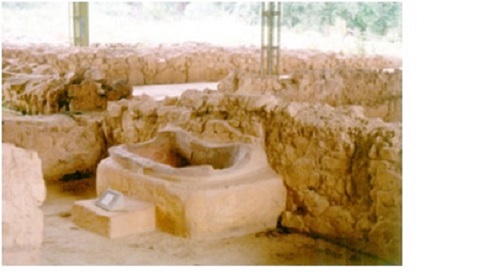
Crete is also believed to be home to one of the first formal bathtubs. Made from clay and then painted, the tub resided in the queen's bathroom and was surrounded by statues and large wall reliefs and frescoes. While the size and shape of the tub closely resemble modern fixtures, there was no drainage capacity and it had to be filled and emptied by hand. The wastewater was emptied into an opening on the bathroom floor which did connect directly to the main waste lines.
Crete was also home to one of the first known 'flushing' toilets. Known as water closets at the time, they relied on stores of rainwater or river water that were collected and used to force wastewater down into the sewers, replacing the discarded water with a fresher supply. The earthquake that hit in 1,400 B.C. damaged or destroyed many of these examples of ancient plumbing techniques, as the city of Knossos was leveled.
Egypt
It is no surprise that early Egypt contributed a great deal to the history and modernization of plumbing. While Crete was becoming renowned for its use of bathtubs and complex sewage systems, Egypt was concentrating on advancing drain and pipe technology, along with attempting to finally harness the power of the Nile.
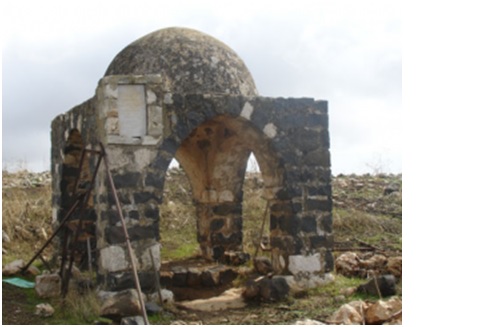
Egyptians were some of the first to rely on deep wells to access clean water supplies deep underground. Often, these wells were dug through solid rock, quite an accomplishment gave the more primitive tools of the time. The Well of Joseph is one of the most remarkable examples of this technique.
Egypt was also one of the first civilizations to begin incorporating metals, such as copper, lead, brass, and bronze, into their plumbing as more than just accent materials. Examples of both lead and bronze drains have been found during numerous archaeological digs. Copper and brass pipes were also found in many areas, replacing the traditional clay pipes being used in the rest of the world at the time.
Elsewhere

Greece was home to some beautifully tiled bathrooms, as well as some of the first self-draining bathtubs. These tubs were often very ornate and ceremonial, typically made from fine stone such as marble or granite.
While baths and showers were typically done with room temperature or slightly cooled water in other parts of the world, the Greeks relied heavily on hot and cold water for bathing purposes. Hot baths, however, were often reserved for the females and the upper-class males.
Jerusalem was known for its innovation with sewer systems. Since cleanliness was such a strong part of their religious beliefs, it was very important to always have sources of clean water to bathe and wash in.
To accomplish this task, they built separate plumbing systems and aqueducts to bring clean water in and then dispose of wastewater afterward. Jerusalem was also the first to explore the concept of reclaimed water, any water that was disposed of would have its solid waste separated from its liquid waste. The solid waste was used as a fertilizer on the crops, and the liquid was, in turn, used to water the harvest.
Pompeii went down in history for the many examples of lead bathroom fixtures, such as ornate bathtubs and sinks. The composition of the items, thankfully, allowed them to survive the great eruption of Mount Vesuvius.
Plumbing History – Developments In Toilet Design
While it seemed that bathtubs, sinks, and drains had all been fairly well developed, there was still one basic plumbing fixture that still needed a lot of work before it was up to par with modern standards. A true flushing toilet was found in Crete during an archaeological dig. The ruins under which it was piled, however, delayed its discovery for many years, leaving the technology and design buried along with it. For the rest of the world, it was back to square one. The development of the toilet as we know it today is an interesting timeline. It took until the 19th century for the next true flushing toilet to be completed.
Sir John Harrington designed the plans for a flushing toilet in the late 1500s. The unit relied on running water to flush away debris and a valve at the base of the toilet to control the flushing itself. Since running water was extremely limited at the time though, his invention remained fairly stagnant.
In 1775, Alexander Cumming developed the S-shaped toilet base that many are familiar with today. This trap eliminated the need for a valve and used water levels to determine when water flow should be stopped or started. Two years later, Samuel Prosser created the plunger component for the toilet, allowing waste to be disposed of and sealed off to prevent the odor from re-entering the room. The use of valves returned in 1778 when Joseph Bramah created the first hinged valve and float valve to further improve toilet operation.
JG Jennings went down in history as the first to introduce the toilet to the public on a large scale. After making improvements of his own, he placed a number of his flushing toilets on display at the Great Exhibition of 1851. The units were installed in the Crystal Palace and allowed attendees to try them for a nominal fee. Nearly 900,000 participants got the chance to use Jennings' design at that event.
In the 1880s, the siphoning system was invented, designed to empty the toilet's cistern for more effective flushing. These modifications were made by Thomas Crapper. While it is a common misbelief that Crapper invented the toilet himself, as you can see from the names and accomplishments that came before him, he merely helped to improve on the basic design.
Plumbing History – Developments In Shower Design
While there were many examples of showers during ancient times, they were all very similar in the fact that they were composed of small quarters the bather would stand in while a slave or servant proceeded to pour large buckets or jars of water over their head. Needless to say, that is far from the concept of a shower as we know it today.
One of the earliest showers, as well as one of the most elaborate, was said to be located within a wealthy English manor house built in the early 1800s. Known today as the English Regency Shower, this piece was not only beautiful and ornate in its design, it was also massive in its scale. Measuring in at just over 12 feet high, the unit was unlike anything else seen or built during this time period.
The English Regency Shower was made from various metals which were then painted by hand to appear as bamboo from a distance. The base of the shower was a large bowl with a built-in drain that was then connected to the upper water tank with the metal poles, measuring nearly 10 feet on their own. The unit was created with an integrated pump system that took the water as it drained down the basin and pushed it back to the upper holding tank. The tank would then disperse the water, creating a recycling effect.
While it was not the most hygienic means of bathing, it apparently served its purpose well enough.
The bather was given privacy using a curtain that was hung on poles surrounding the upper water tank, the forerunner to the modern shower curtain as we know it today. The English Regency Shower was also the unit behind the invention of one of the first shower caps. Unlike modern shower cap designs, this version was a tall cone-shaped metal hat the bather would wear to keep his or her hair dry. While bathing practices had become more frequent during this time period, washing the hair was often done with the use of scented oils and herbs, not soap and water.
The Golden Age of Plumbing
The tail end of the 19th century, particularly between 1880 and 1899, has long been considered the dawn of the golden age of plumbing. This was not only one of the first times that plumbing was recognized as its own trade, but it was also the first time that plumbers began to be considered skilled tradesmen. It is only in the last hundred years or so that the plumbing industry has flourished, leading to the creation of multiple trade associations and plumbers' unions. The National Association of Master Plumbers was founded in 1183 and both the Mechanical Contractors of America and the United Associated Plumbers Union were established in 1889.
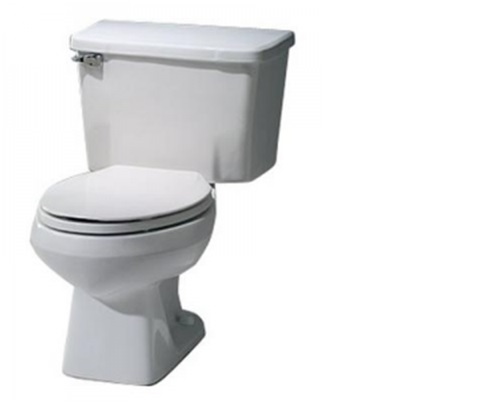
Some say it was the mastery of the toilet design that led to this prosperous boom that seems to still be going strong. Once the sanitation and odor issues that had long plagued toilet design were eliminated, the concept of indoor plumbing spread faster than anyone could have ever imagined. Also, once manufacturers had perfected their basic designs as best they could for the times, greater emphasis was once again placed on the visual aspects of the plumbing fixtures, as these were now just as important to people as the functional aspects of the devices.
Sinks, tubs, and toilets gradually became standard fixtures in nearly every home, followed closely behind by true showers. Coincidentally, the overall public health seemed to improve greatly as well during these times. Many experts often contribute this more to the improvements made in sanitation and hygiene practices that were being made, as opposed to advances being made in the medical sciences.
Modern Plumbing
Today's plumbers are still considered highly skilled tradesman and still have a wealth of private and public associations and unions which cater to their needs. Becoming a licensed plumber not only requires several years of experience, but it can also include various levels of schooling and certifications, as well as the need to successfully pass a series of detailed exams on various aspects of the plumbing industry. Their jobs also entail much more than just the basic bathroom fixtures, such as baths and toilets. Plumbers are now responsible for more modern designs, such as water heaters, swimming pools, residential septic systems, and irrigation systems.
Plumbers can choose to do general contracting work, becoming certified to handle any general plumbing repair or installation needs within the home, or they can opt for a more specialized career in a specific niche market within the industry itself. They can also choose to focus on strictly residential plumbing tasks or choose to handle larger-scale commercial and industrial applications.
Modern Plumbing Tools
To perform their job correctly, a plumber must be well equipped with the proper tools. While it is common to have a mini-tool kit specific to plumbing needs around the house, often equipped with a wrench or two, some plumbing tape, and a hand full of washers, the professional plumber's arsenal of tools is much more extensive.
Wrenches
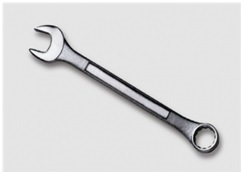
Fixed Wrench
Plumbing wrenches come in two basic designs, adjustable wrenches, and fixed wrenches. As their names imply, fixed wrenches are designed to fit specific sizes of pipes, valves, bolts, etc.
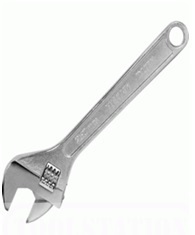
Adjustable Wrench
Adjustable wrenches, on the other hand, can be made to fit several various sized items, with each wrench covering a small to moderate range on the overall sizing scale. The most common wrench size for residential applications has a 12" handle.
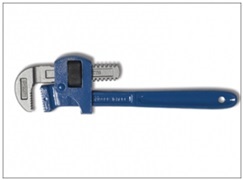
Stillson Wrench
Stillson wrenches are one of the most common types of wrenches used for rounded surfaces, primarily plumbing pipes. Stillson wrenches tend to be fairly affordable and rely on adjustable steel jaws set into the housing to grip and move the piping. Like general wrenches, Stillson wrenches are commonly found in the 12" variety, however, 18" Stillson wrenches are also quite common.
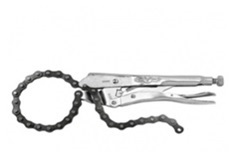
Pipe Wrench
Pipe wrenches are another type of wrench used for rounded surfaces. Unlike Stillson wrenches, pipe wrenches tend to be slightly more costly, particularly since they are subject to much less potential distortion. They consist of a section of the heavy chain which is attached to a steel handle. The chain is placed around the pipe or rounded item that needs to be adjusted and then tightened in place. The notches on the handle, also known as teeth, help to grip the pipe securely, while the pipe is held firm by the pressure of the chain. A pipe wrench can also be used on other items, including angled and irregularly shaped pipes. This versatility stems from the fact that the chain can be made to fit and conform to a variety of shapes other than just round pipes.
While Stillson wrenches and pipe wrenches are the two most common types used for plumbing repairs and installations, there are several other varieties of wrenches that a skilled plumber will rely on in his day to day activities.
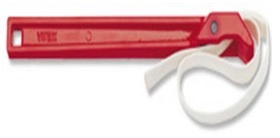
Plumbing Strap Wrench
When dealing with softer pipe materials, such as plastic, aluminum, or lead, a strap wrench is recommended. A strap wrench works on the same basic principle of the pipe wrench but uses a leather or fabric strap to wrap around the item instead of a chain. Using fabric eliminates the need for the teeth and chain which can cause extensive damage when used on softer materials.
End wrenches are used in smaller areas or where pipes have been mounted in close quarters to one another. Their slim design helps them to better fit into confined spaces and between close-set pipes.
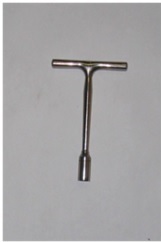
Plumbing Nipple Wrench
Nipple wrenches, also known as extractors, are also heavily relied on in smaller work areas. They rely on hex fittings for ease of use.
The hex setting itself is, of course, most commonly found on hex wrenches. The basic design of a hex wrench features an end that is designed to fit a variety of square or multi-sided objects. The hex wrench fits over the item needing to be tightened or loosened, wrapping around it firmly to ensure a proper grip. Because of their snug fit and soft surfaces, hex wrenches are also preferred for more decorative finishes, such as chrome, as they are less likely to scratch the surface as many standard wrenches may.
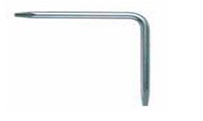
Seat Wrench
Seat wrenches also feature hex settings and are used specifically for a variety of faucet seating shapes and sizes.
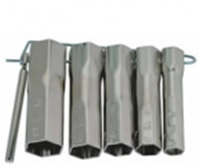
Nut Socket Wrench
With regards to bath and shower repairs and installations, packing nut socket wrenches are a staple in any plumber's tool kit. These wrenches are typically found in large sets and feature double-ended hex settings designed to fit the full range of standard tub and shower faucet stems. The hex settings are crucial as almost all tub and shower faucet stems are made from pliable brass which is too easily damaged by standard wrenches. A damaged faucet stem is also nearly impossible to replace without damaging or taking apart the wall that the faucet stem is mounted into.
Pliers
Another top category of plumbing tools is pliers. Locking pliers, slip joint pliers, and expanding jaw pliers are some of the most common types in use.
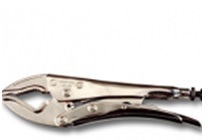
Locking Pliers
Locking pliers are often included in the wrench category as their method of operation is very similar. They are fully adjustable and, once in the right position, can be locked down with a firm grip on the pliers handle.
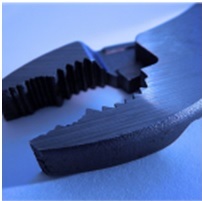
Slip Joint Pliers
Slip joint pliers and expanding jaw pliers, on the other hand, are slightly more manual in their operation.
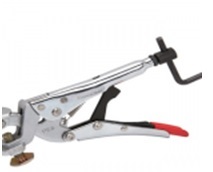
Expanding Jaw Pliers
While slip-joint pliers are used to gripping down on pipes and fittings, expanding jaw pliers are placed into an opening, such as a drain, and then expanded to grip the inside walls.
Key Takeaway
From ancient clay pipes to modern PEX tubing, plumbing has been essential to human civilization for millennia. The innovations of countless engineers and craftspeople have given us the reliable, safe water systems we often take for granted today. Understanding this rich history helps us appreciate the complexity and importance of modern plumbing systems.